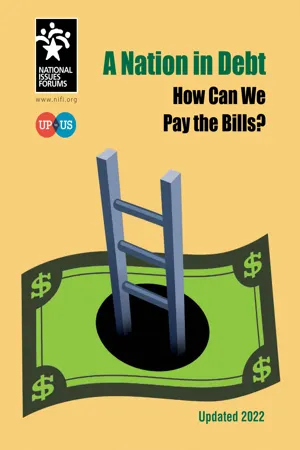Economics
National Debt
National debt refers to the total amount of money that a government owes to its creditors. It is the accumulation of annual budget deficits, where the government spends more than it collects in revenue. National debt is typically financed through the issuance of government bonds and can have significant implications for a country's economy, including interest payments and potential impacts on future generations.
Written by Perlego with AI-assistance
Related key terms
11 Key excerpts on "National Debt"
- eBook - ePub
The Macroeconomic Environment of Business
Core Concepts and Curious Connections
- Maurice D Levi(Author)
- 2014(Publication Date)
- WSPC(Publisher)
CHAPTER 2 National Debt“The government is the only organization that can run a deficit and still make money.”AnonymousKey Concepts: National Debt; fiscal deficit; public debt; gross debt; National Debt relative to national product; National Debt versus corporate and personal debt; foreign debt versus domestic debt; debt growth and pensions; debt retirement and inflation; debt incurred for infrastructure and human capital.National Debt AND FISCAL DEFICITSAn economic magnitude which has attracted increased attention in recent years is the National Debt, also sometimes referred to as the public debt. The National Debt is the amount owed by the national government and is represented by the value of government bonds that lenders to the national government hold. The debt represents the accumulation of government borrowing that has occurred over past years to finance fiscal deficits. Just as the debt increases when the government runs fiscal deficits—spending more than it receives in tax revenue—it is reduced when there are fiscal surpluses, i.e., when tax revenue exceeds what the government spends. If we include intergovernmental debt and debt obligations such as social security we then have gross debt. The top part of Fig. 2.1 shows vividly why the National Debt has become a focus of attention; between 1980 and 2010 the U.S. National Debt increased by several hundred percent.A commonly-expressed concern is that National Debt represents a burden on future generations, and indeed, at the extremely rapid rate at which the debt is growing, it represents a future burden on people working today.Fig. 2.1. The U.S. National Debt has grown rapidly in recent years.Source: http://upload.wikimedia.org/wikipedia/en/3/3b/USDebt.png . While U.S. National Debt and public debt have both grown rapidly in the last three decades, their importance relative to the size of the economy is not greater than it was at the end of the Second World War. - eBook - ePub
What We Owe
Truths, Myths, and Lies about Public Debt
- Carlo Cottarelli(Author)
- 2017(Publication Date)
- Brookings Institution Press(Publisher)
Part I THE PUBLIC DEBT PROBLEMPassage contains an image ONE What Is Public Debt? Public debt—the total of the nation’s debts; debts of local and state and national governments; an indicator of how much public spending is financed by borrowing instead of taxation. —Definition of public debt from www.webster-dictionary.org
Let’s start with the basics: what is public debt, and where does it come from? If you already know the basics, you can jump to chapter 2 , but it may still be worth reading the last two sections of this chapter, “Money and Public Debt” and “The Missing Debt.”The Basics: Government Deficit, Government Surplus, and Public DebtNever trust those who tell you that a government’s budget is like a household’s budget. In many respects it is not. And yet similarities in some basic aspects do emerge. So, let’s think about your own household. Your annual income is $60,000, but you need to spend $70,000. How do you bridge the $10,000 difference? You borrow from your bank at an interest rate of 5 percent, to be paid next year. If you start your year with zero debt, by the end of the year your debt will be $10,000. Next year, nothing changes, except that your expenses rise from $70,000 to $70,500 as you must pay the bank $500 for interest on your debt. Your bank, however, is generous and not only rolls over the initial debt but lends you another $10,500 to cover your new imbalance between your revenues and your spending. At the end of the second year, your debt has reached $20,500.Let’s now introduce some terms that economists use to talk about government finances. The imbalance between the government spending and its revenues (in the above household example, $10,000 in the first year and $10,500 in the second year) is called the government, or fiscal, deficit . The amount the government owes at the end of the year is the public, or sometimes government or national, debt (in the example above, $10,000 after one year and $20,500 after two years). It grows because the government has a deficit. Indeed, broadly speaking, public debt is the cumulative sum of all previous deficits.1 - No longer available |Learn more
A Nation in Debt
How Can We Pay the Bills?
- Sutton Stokes(Author)
- 2019(Publication Date)
- NIFI/National Issues Forum Institute(Publisher)
A Nation in DebtHow Can WePay the Bills?
IT IS NOT UNUSUAL—and not necessarily a problem—for a government to have at least some debt. But how much is too much? Many Americans think the US National Debt is too large and want to try to get it under control.How large is the National Debt?By the end of fiscal year 2018, the US government owed around $21.7 trillion in gross federal debt ($15.8 trillion in public debt and $5.9 trillion in intragovernmental debt—money that is owed by one part of the government to another part). It was $10 trillion just ten years ago and is projected to rise to $34 trillion in another decade.What’s the difference between the national debt and the national deficit?National deficit and National Debt are not the same. When our government spends more than it earns in taxes during a year, the shortfall is referred to as the deficit. Most years, the US government runs a deficit. In 2015, the deficit was $438 billion; in 2016, it had risen to $585 billion, and in 2018, the deficit reached $779 billion.Source: The White House, Historical Tables, Table 7.1, https://www.whitehouse.gov/omb/historical-tables/ *As of 10/15/2018, Treasury Direct, https://treasurydirect.gov/NP/debt/current Note: Graph shows rise in debt from decade to decade but does not reflect fluctuations in debt between decades.When there is a deficit, the country must borrow money to make up the difference, adding to the national debt.How does the US government borrow money?The US cannot just take out a bank loan when it needs to borrow money. Instead, it issues Treasury bonds—basically IOUs that are purchased by individuals, organizations, and other governments. When these bonds mature, the government pays back the money plus interest. US bonds are considered extremely safe investments and will continue to be—as long as investors believe there is no way the US government would default and fail to pay them back. - eBook - ePub
America's National Debt
Examining the Facts
- Thomas Arndt(Author)
- 2022(Publication Date)
- ABC-CLIO(Publisher)
The National Debt certainly does have an impact on the broader economy, including most of the textbook economic forces that are part and parcel of a free market. Interest rates, inflation rates, stock market prices, and practically all other economic metrics are in various ways affected by public-sector actions, especially the scale of its borrowing habits. Generally, the repercussions of growing public-sector debt are believed to create substantial benefits, at least in the short term, because aggregate demand is being created, spurring economic activity. However, critics of excessive federal government borrowing suggest that there are significant longer-term burdens associated with public debt increases such as upward pressure on interest rates and inflation rates, and likely suppressed returns in investment markets as well. The Facts: Many viewpoints converge on the notion that excessive government debt is harmful to the economy, broadly speaking. At a point, too much public-sector borrowing can certainly crowd out private investment, cause a spike in interest rates, inflate the money supply, and even precipitate a sizable financial crisis (one of confidence as well as actual valuation). The real question is where “appropriate” levels of borrowing end and “excessive” levels of borrowing begin. Demand-side economists of the 20th century, such as John Maynard Keynes, argued that public-sector deficit spending ought to be pursued aggressively as a default policy approach, particularly if and when economic distress or a substantial downturn was at hand. When the government spends more than it takes in, it issues bonds or other financial instruments to cover the difference. That amount of money can essentially be thought of as cash being injected into the economy, and as the thinking goes, it generates growth in production, employment, wages, and so on - No longer available |Learn more
- Sutton Stokes, Tony Wharton, Brad Rourke(Authors)
- 2023(Publication Date)
- NIFI/National Issues Forum Institute(Publisher)
A Nation in DebtHow Can WePay the Bills?
IT IS NOT UNUSUAL—and not necessarily a problem—for a government to have at least some debt. But how much is too much? Many Americans think the US National Debt is too large and want to try to shrink it.How large is the National Debt?By late 2022, the US government owed $31.1 trillion ($24.3 trillion in public debt and $6.8 trillion in intragovernmental debt—money that is owed by one part of the government to another part). It was $16 trillion 10 years ago and is expected to rise to $45 trillion in a decade.In the past three years, government spending to offset the effects of the COVID-19 pandemic and lockdown on the economy added more than $5 trillion to the debt. The urgency of the pandemic ended, at least temporarily, battles in Congress over raising the legal limit on the federal debt, the “debt ceiling.”What’s the difference between the national debt and the national deficit?National deficit and National Debt are not the same. When our government spends more than it earns in taxes, the shortfall is referred to as the deficit. Most years, the US government runs a deficit. In 2021, during the height of spending on the pandemic, the deficit rose to $2.8 trillion, then dropped to $1 trillion in 2022. It is projected to stay more than $1 trillion per year in the near future.Source: US Treasury Data LabWhen there is a deficit, the country must borrow money to make up the difference, adding to the national debt.How does the US government borrow money?The US cannot just take out a bank loan when it needs to borrow money. Instead, it issues Treasury bonds—basically IOUs that are purchased by individuals, organizations, and other governments. When these bonds mature, the government pays back the money plus interest. US bonds are considered extremely safe investments and will continue to be—as long as investors believe there is no way the US government would default and fail to pay them back. - eBook - ePub
Public Finance and Islamic Capital Markets
Theory and Application
- Syed Aun R. Rizvi, Obiyathulla I. Bacha, Abbas Mirakhor(Authors)
- 2016(Publication Date)
- Palgrave Macmillan(Publisher)
Another classification of government debt is in their nature of contribution. Voluntary debt is primarily when members of society provide debt to the government on a voluntary basis. This debt can be obtained in the form of market loans, bonds and so onWhile compulsory debt is a phenomenon becoming more common in developing countries, the rate of interest on such loans may be low, and governments issue these debt securities to central bank and government-owned entities to bridge their budget deficit.Internal Versus External
Another classification of government debt is through the domiciled nature of the lenders. Internal debt refers to the funds borrowed by the government from various sources within the country. The government may borrow from individuals, banks, business firms and others, and popularly through standard instruments like market loans, bonds, treasury bills, ways and means advances and the like.External debt is raised through foreign countries or international institutions and is payable in foreign currency, usually US dollars. An external loan initially involves a transfer of resources from foreign countries to the domestic country but when interest and the principal amount are being repaid a transfer of resources takes place in the reverse direction.Debt Dynamics of the Current World
The trend in the debt dynamics of the world has been worrisome to say the least over the past few decades. While the global debt today stands at a horrific nearly three times the global production, no lessons seem to have be learnt from the recent financial meltdown. Global debt increased by estimated $57 trillion in the seven years following the financial crisis, with most economies recording higher levels of borrowing relative to gross domestic product (GDP) than they did in 2007.In a recent study by the McKinsey Global Institute, shocking results have been found in the analysis of evolution of debt in 47 countries. The government debt is “unsustainably high” in most of them, growing by $25 trillion since 2007. It further found that in ten of the countries studied, debt exceeds 100% of GDP, with worrying news that government debt-to-GDP ratios will continue to rise over the next five years in a number of countries including Japan, the USA and most European countries (except Germany, Ireland and Greece), according to the study. - eBook - ePub
The Public Debt Problem
A Comprehensive Guide
- P. Lemieux(Author)
- 2013(Publication Date)
- Palgrave Macmillan(Publisher)
consolidated debt is calculated. So many analysts believe that the true debt of the federal government is better represented by its external debt, or debt held by the public. Note, however, that this will do nothing to pay for the future obligations of Social Security and Medicare. The central role that the external debt, or debt held by the public, plays in statistics and debates can thus be misleading.Every year, the federal government reimburses the part of its external debt that becomes due, that is, the securities that mature, and issues new securities if necessary. Typically, it does not reimburse anything, but issues new securities to reimburse the old ones: we say that the debt is “rolled over.” When the government borrows more than it reimburses, the total debt held by the public rises. As Chart 2.1 shows, this is what happened during FY 2010, where the net borrowing was $1.5 trillion, pushing the debt held by the public from $7.5 trillion to $9.0 trillion. That this amount corresponds exactly to the deficit to be financed is no surprise: this increase in the debt held by the public was precisely required to plug the budget hole. The net annual borrowing from the government corresponds to the cash deficit to be financed. The rest of the gross debt was financed internally, as we saw, by the government borrowing from itself. (This last point is important to understand in order not to be surprised by the fact that the increase in the gross federal debt is not equal to the deficit.)The federal deficit ($1.3 trillion dollars in 2010), which is the main component of the gap to be financed, is mainly made of current, not investment, expenditures. What the federal government does, and has done for several decades, is to borrow in order to pay for current expenditures—borrow to pay the groceries, as it were. No ordinary individual or family or business would survive this way. Only a sovereign can—at least for a time. - eBook - ePub
- James L. Clayton(Author)
- 2016(Publication Date)
- Routledge(Publisher)
In 1980, the net liability figure was −10.4 percent of GDP, and in 1996 government liabilities had risen to −41.6 percent of GDP. This rapid increase in the scale of net government liabilities is worrisome. If this rate of increase continues, the connection between deficits and interest rates and “crowding out” will likely become much stronger. How much stronger? 4. Do large deficits today place a burden on future generations who will have to pay higher taxes tomorrow? There is no question that using debt to fund current expenditures is very much like deferring tax payments to some future time when interest and principal come due. 59 Citizens simply agree to pay for these expenditures later, rather than at the time they are made. Since the average maturity of a U.S. government bond is about six years, and the median about three years, the length of time into the future we are talking about is really quite short, because federal debt is rolled over rapidly. 60 Since total debt owed is generally not paid down—or at least for most G–7 countries it is not paid down for very long—rising public debt is a very long-term phenomenon. Public indebtedness can rise rapidly—to fund a war for example—but it seldom declines rapidly. Whether one generation is “burdened” by another is a complex question. Long-run and short-term effects need to be considered. Whether the burden is to be placed on individuals or on the economy as a whole and whether to use traditional methods or newer “generational accounting” methods are only two of the considerations in this debate. 61 Which government expenditures should be financed by taxes and which by debt is also a problem. How to measure the benefits of spending on national security, law and justice, roads, education, and other public matters that benefit individuals, while deducting the cost in taxes and interest payments on public debt that represent a cost for individuals, is also a problem for which there is no clear answer - eBook - ePub
China's Fiscal Policy
Theoretical and Situation Analysis
- Gao Peiyong(Author)
- 2018(Publication Date)
- Routledge(Publisher)
The interest effect of NDM means the rise and fall of interest rates on the financial market as a result of regulating the issuance of National Debts or the level of actual interest rates so that total social demand will be subject to expansionary or contractionary policy. The transmission mechanism can be described as follows: the fluctuation of interest rates of National Debts → fluctuation of interest rates on the financial market → fluctuation of total social demand.First, the government may opt to regulate the interest rate of National Debts, which can be achieved by determining the level of the interest rate. In the context of a modern market economy, the interest rate of National Debts is a typical rate on the financial market that reflects the government’s macroeconomic policy and may make a direct difference between rise and fall of interest rates on the financial market. With regard to the current situation in China, although the interest rate of National Debts is contingent on the savings rate, the enterprization of specialized banks represents an irresistible trend as market orientation reform deepens. Once this requirement is satisfied, no longer will the interest rate of National Debts follow the savings rate. Such being the case, the interest rate of National Debts will be an effective method for the government to influence the market interest rate and then to implement its macroeconomic policy. For instance, if the expansionary economic policy is necessary, the interest rate of National Debts can be lowered to bring down all interest rates on the financial market, thus stimulating consumption and investment to increase the total social demand; if it is necessary to adopt contractionary economic policy, the interest rate of National Debts can be raised to improve all interest rates on the financial market, thus suppressing consumption and investment to reduce the total social demand. - eBook - ePub
- Donijo Robbins(Author)
- 2017(Publication Date)
- Routledge(Publisher)
This question relates in important ways to the stability of the government. At what point is a debt level so high that it impedes either the economy in which the government operates, the ability of the government itself to function as its citizens wish, or both? Although the U.S. has a legislated ceiling for the National Debt, there are no guidelines for appropriate debt or deficit limits for the U.S. national government based on a theoretical rationale. The European Union has established debt requirements for its member nations. Many state and local governments in the U.S. have debt limits. Many states, for example, have statutory or constitutional debt limits for state government debt. Many impose limits on the debt that local governments in the state can incur. Accurately defining what debt is covered by these limits can be difficult, and state and local governments often change the type of borrowing they do in order to avoid these limits (Sbragia, 1996).Typically, debt levels are expressed as a percent of some measure of wealth or of the capacity to repay the debt such as a percent of GDP for nations, of gross personal income for states, or of assessed valuation for local governments. Measuring it as a percent of annual revenues or — as is more likely — as a multiple of annual revenues is also common. Other measures are used to assess the burden or average burden. These include debt per person or debt per household. Many states express debt limits as a dollar amount or as debt per capita (Bunch, 1991; GAO, 1996).Capacity measures may provide an inherent indictor of whether debt is too high; however, they are best used for comparison, to compare the debt level for one government over time and debt levels among governments (Evans, 1997). It would be difficult to find a consensus among economists about what a prudent ceiling for the debt-to-GDP ratio or the deficit-to-GDP ratio should be. The European Union, however, set a ceiling of 3% of GDP for member countries for the deficit (Evans, 1997; http://europa.eu.int - eBook - ePub
- James Gosling, Marc Allen Eisner(Authors)
- 2015(Publication Date)
- Routledge(Publisher)
Budget of the United States Government, FY 2011, Historical Tables , Table 7.1. * =estimate.It is nonetheless true that the federal government has become increasingly dependent on foreign institutions and individuals to finance its debt. Historically, the federal government has not been nearly as reliant on foreign capital to finance its debt. During most of American history, individuals and institutions within the United States held nearly all the federal debt.Another way of putting America’s debt load in perspective is to compare the federal government’s debt with that of other wealthy democracies, focusing solely on publicly held debt issued by the central government, not including debt issued by subnational governments. Table 5.4 shows the results of that comparison for 2010, the most recent year for which comparable data are available. The National Debt burden of the United States is close to the average for nations with which it is usually compared, but its comparative position has worsened significantly in recent years, given the substantial budget deficits.Table 5.4Comparative National Government Public Debt as a Percentage of GDPNation Debt/GDP Japan 183.5 Greece 147.8 Belgium 96.8 United Kingdom 85.5 France 67.4 United States 61.3 Spain 51.7 Poland 49.7 Germany 44.4 Canada 36.1 Sweden 33.8 Mexico 27.5 Australia 11.0 Source: Organization for Economic Cooperation and Development, Central Government Debt, International Comparisons , 2010. Note: OECD’s reported percentage differs by one percentage point from that reported by OMB in Table 5.3 .INTEREST OBLIGATION ON THE DEBT
The fiscal implications of the federal government’s debt hit home in the federal budget. Net interest payments on the debt have constituted a growing share of federal budget outlays. Although net interest is not an entitlement program per se, budget makers treat it as a form of uncontrollable spending, given that it is highly unlikely that the U.S. government would fail to honor its interest obligations. Rising net interest costs tend to crowd out other federal discretionary spending, particularly in the constrained environment of deficit reduction.
Index pages curate the most relevant extracts from our library of academic textbooks. They’ve been created using an in-house natural language model (NLM), each adding context and meaning to key research topics.










